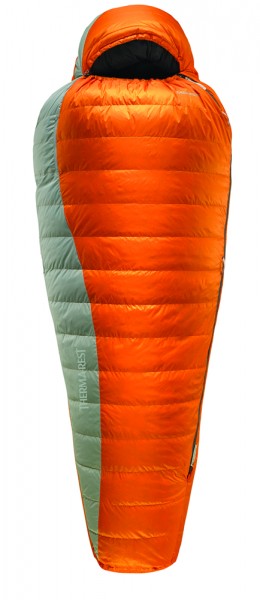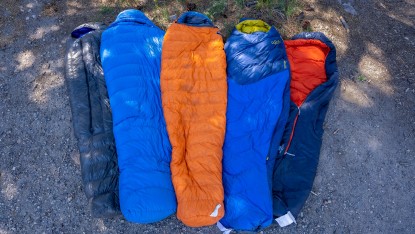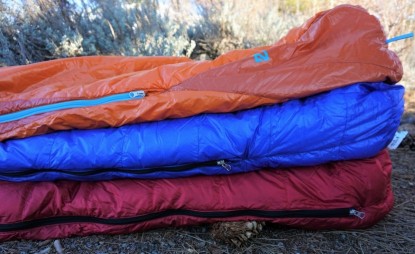Therm-a-Rest Antares Review
Our Verdict
Our Analysis and Test Results
Hands-On Review
Design Overview
The Antares has no insulation on the bottom (a common feature found in the quilts tested in our Ultralight Sleeping Bag Review), a 3/4 length zipper, a hood, and two elasticized mesh loops that slip over 20"-25" sleeping pads so that the bottom of the bag stays attached to a pad, which insulates you from the ground. The bag's design merges some ultralight components, such as the absence of insulation on the bottom, with traditional features like the zipper and hood.
Warmth
Therm-a-Rest gives the Antares a 20 degree Fahrenheit rating, which is on par with most other manufacturer ratings (and overestimates warmth in real world conditions). The bag kept our testers warm into the low 40's or upper 30's, depending on who was using it. It has an EN Comfort rating of 34 F. If you are camping on snow or if the temperature is approaching freezing it can be important to use a moderately warm sleeping pad to insulate you from the ground. Most of our testing occurred from February to late May in Michigan, Kentucky, California, and Washington State.
Weight
The Antares weighs in at 31.9 ounces on our scale. It is one of the heaviest three-season down sleeping bags we've tested and it walks our testers' “too heavy for serious backpacking” line. We rarely carry sleeping bags that are this heavy for backpacking. When we do, the bags are often much warmer.
The Antares has two features that contribute most directly to its considerable weight: (1) moderate quality 750-fill down and (2) fixed pad attachment loops.
moderate quality 750-fill downAs you can see in the specifications table above the bag has 14 ounces of 750-fill down (that's 10,500 cu in of down). Sleeping bags that use lower fill power down need to add more down to achieve the same warmth as bags that use higher fill power down. For example, one ounce of 450-fill down occupies 450 cubic inches and one ounce of 900-fill down occupies twice that volume!! The Antares would be warmer, weigh less, and pack smaller if it used higher quality down.
fixed pad attachment loopsThe Antares' fixed pad attachment loops are a weight-inefficient method to attach the bag to a pad. Other bottomless bags have excellent, secure, adjustable pad attachment methods that weigh very little, probably less than 0.5 ounces. The Antares' pad attachment straps increase weight without contributing to warmth and make the bag relatively cold for its warmth compared to other down backpacking bags; the Antares' other components (shell fabric, zippers, pad attachment loops) weigh 17.9 ounces—more than the down insulation!! This illustrates that the bag puts too much attention to the “other things” and not enough focus on the insulation. Keeping you warm, after all, is the primary purpose of a sleeping bag.
Nearly all of the other hooded down backpacking sleeping bags we've tested are warmer for their weight than the Antares. Hoodless ultralight sleeping bags, our testers' favorite for three-season backpacking and climbing trips, blow the Antares out of the water when it comes to warmth to weight ratio. Let's consider two examples of other bags that have high warmth to weight ratios. The Western Mountaineering Versalite, a fully featured 10 degree traditional style bag with a full zip and hood, weighs exactly the same amount as the Antares but has 20 ounces of 900-fill power down, or 18,000 cu in of down (again, the Antares has 10,500 cu in), and the material weight is 11.9 ounces- a full 6 ounces less than the Antares' material weight. Our tests show that the Versalite is nearly twice as warm as the Antares, yet both bags weigh the same. We also tested other bags, like the ZPacks Classic, a hoodless ¾ length zipper bag, that are almost as warm as the Antares and weigh nearly half as much- only 17 ounces. These examples show that the Antares does not compete with other top-tier bags on either warmth or weight.
Comfort
The bag's very secure pad straps keep you firmly attached to a pad, which could be useful if someone or something, perhaps a dog, were trying to push you off your pad. For most people, however, the straps are unnecessarily secure. In combination with the lack of insulation on the bottom we feel they have the net effect of reducing comfort because in warmer temperatures when you want to drape the bag over your body like a quilt you can't attach it to a pad and only half the bag has insulation, so it's challenging to regulate your temperature evenly. And the straps dangle limply on the uninsulated side of the bag. We have the same complaint with the company's Navis sleeping bag.
Numerous testers commented that the Antares was less comfortable than most traditional sleeping bags. Its hood, in particular, was not comfortable when fully cinched tight. Smaller hood opening are generally the most comfortable; of the three-season bags we've tested the Mountain Hardwear Phantom 15 and Marmot Plasma 15 have the most comfortable hoods.
Storage Sack
The Antares comes with a low quality mesh storage sack. We prefer cotton or a solid synthetic material because it helps to keep the bag cleaner.
Better Sleep Guarantee
Therm-a-Rest has a Better Sleep Guarantee that allows you to return—no questions asked— any bag within 90 days if you are not completely satisfied. This program provides a low risk opportunity to try out the Antares, or their other bags.
Value
Although the Antares retails for slightly less than many other top three-season down bags we feel that its performance drawbacks makes it a poor value. This is illustrated graphically in our Backpacking Sleeping Bag Price Versus Value Chart.





